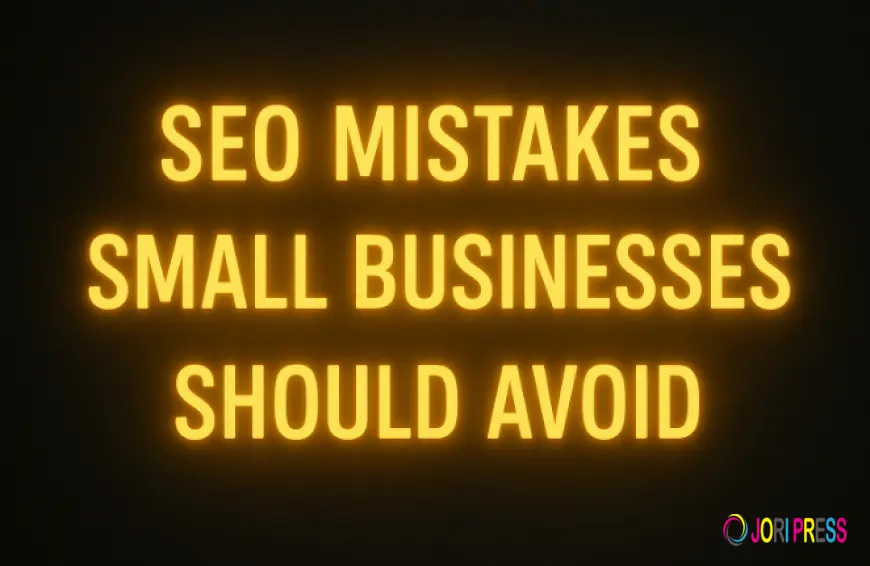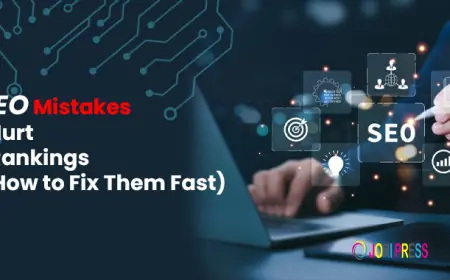SEO Mistakes Small Businesses Should Avoid
Discover the most common SEO mistakes small businesses make and learn practical tips to boost rankings, increase traffic, and grow your online presence.

Running a small business is already a full-time job. Between serving customers, handling finances, and keeping operations smooth, it’s easy to overlook search engine optimization (SEO). Yet SEO is one of the most cost-effective ways to bring in steady, long-term traffic. Unfortunately, many small businesses unknowingly make mistakes that hold them back from showing up in search results.
Below are the most common SEO mistakes small businesses should avoid, along with practical tips to get things right from the start.
Ignoring the Basics of Keyword Research
Many small businesses create content without checking what people actually search for. They either target overly broad keywords (“shoes,” “plumber”) or ignore search intent altogether. The result? A site that attracts the wrong visitors—or none at all.
How to fix it:
Use free tools like Google Keyword Planner, Ubersuggest, or even the “People also ask” section on Google to find phrases your customers type every day. Focus on a mix of low-competition, high-intent keywords that match your products or services. This ensures you’re reaching people who are ready to buy, not just browse.
Skipping On-Page Optimization
Even when businesses know their target keywords, they often forget to optimize key elements of each page. Missing title tags, duplicate meta descriptions, and unoptimized headers can confuse search engines and reduce rankings.
Quick checklist:
-
Include the main keyword in the title tag and at least one H2 heading.
-
Write a compelling meta description that encourages clicks.
-
Use descriptive, keyword-rich alt text for images.
-
Keep URLs short, clean, and easy to read.
Small changes like these send clear signals to Google about what your page is about.
Neglecting Local SEO
If you run a service-based business, a restaurant, or a local shop, local SEO is your best friend. Yet many owners forget to claim or update their Google Business Profile. Without it, you’ll struggle to appear in the “map pack” or for searches like “near me.”
Action steps:
-
Claim and verify your Google Business Profile.
-
Add accurate contact details, business hours, and high-quality photos.
-
Encourage satisfied customers to leave reviews.
This not only boosts visibility but also builds trust with potential clients.
Slow or Unsecured Websites
Speed and security matter more than ever. A slow-loading site frustrates visitors and increases bounce rates, while an unsecured (HTTP) site can scare users away. Both factors directly affect your rankings.
Solutions:
-
Use tools like PageSpeed Insights to check performance.
-
Compress images, enable browser caching, and consider a reliable hosting provider.
-
Always install an SSL certificate (HTTPS) to protect user data.
Thin or Duplicate Content
Google rewards fresh, valuable content. Pages with just a few lines of text or copied material from other sites rarely perform well. Thin content signals that your website lacks expertise or relevance.
Better approach:
Create helpful, original content that answers your customers’ real questions. Blog posts, FAQs, and detailed service pages show Google—and your visitors—that you know your field.
Forgetting Mobile Optimization
More than half of web traffic comes from smartphones, yet some small businesses still rely on outdated, desktop-only designs. A site that doesn’t work well on mobile is nearly invisible in today’s search landscape.
Tip:
Choose a responsive website theme and regularly test your site on different devices. Google’s Mobile-Friendly Test can reveal any issues that need fixing.
Overlooking Analytics and Tracking
SEO isn’t “set it and forget it.” Without tracking, you’ll never know which pages bring traffic or where improvements are needed.
Key tools to install:
-
Google Analytics for visitor behavior and conversions
-
Google Search Console for keyword rankings, click-through rates, and technical errors
Monitoring these metrics helps you adjust strategies before small issues become big problems.
Chasing Shortcuts or Black-Hat Tactics
It can be tempting to buy backlinks, stuff keywords, or hide text to “trick” search engines. But Google’s algorithms are smarter than ever. Black-hat tactics often lead to penalties, lost rankings, or even de-indexing.
Stay safe by:
-
Building high-quality backlinks naturally (guest posts, partnerships, local directories).
-
Writing content for humans first, not algorithms.
-
Following Google’s Webmaster Guidelines.
Not Investing in Professional Help When Needed
DIY SEO is possible, but as competition grows, professional guidance can make the difference between page ten and page one. A good SEO team can identify technical issues, create content strategies, and track performance so you can focus on running your business.
For small businesses looking for affordable, results-driven SEO support, check out SEO services tailored for small businesses. Partnering with experienced professionals can save time, prevent costly mistakes, and accelerate growth.
Overlooking Internal Linking
Many small sites focus on getting external backlinks but forget to connect their own pages internally. Internal links help search engines discover your content, distribute page authority, and guide visitors toward key services.
What to do:
Add contextual links within your blog posts and service pages that point to related content. Use descriptive anchor text so Google understands the relationship between pages. A smart internal linking strategy keeps visitors engaged and spreads SEO value across your site.
Ignoring User Experience (UX)
SEO isn’t just about keywords and code. Google now measures how real people interact with your site. If visitors leave quickly because the design is confusing or pop-ups are annoying, your rankings can drop.
Improve UX by:
-
Using clear navigation and a clean layout.
-
Ensuring fonts and buttons are easy to read and click.
-
Reducing intrusive pop-ups or ads that interrupt browsing.
A site that feels pleasant to use encourages longer visits, repeat traffic, and better search performance.
Final Thoughts: Build a Strong SEO Foundation
Search engine optimization isn’t a one-time task—it’s an ongoing process. By avoiding these common mistakes and focusing on the fundamentals, small businesses can steadily climb search rankings, reach more customers, and grow revenue without overspending on ads.
Remember, SEO success doesn’t happen overnight. But with patience, smart strategies, and consistent effort, your small business can build the kind of online presence that keeps customers finding you long into the future.
What's Your Reaction?
 Like
0
Like
0
 Dislike
0
Dislike
0
 Love
0
Love
0
 Funny
0
Funny
0
 Angry
0
Angry
0
 Sad
0
Sad
0
 Wow
0
Wow
0
















































